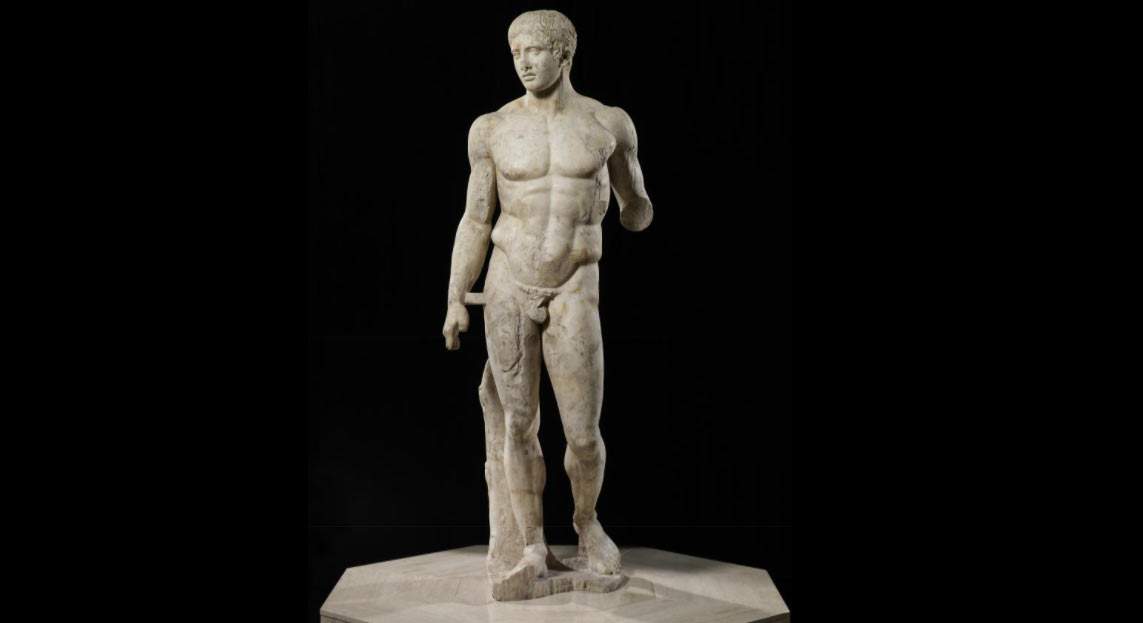U.S. must return Stabie Doriforo, stolen in 1970s, to Italy
Italy is asking the United States for the return of the Doriforo di Stabiae, one of the most important works of the Minneapolis Institute of Art: made of Pentelic marble, it is a Roman copy, executed at the turn of the first century B.C. and the first century A.D., of the famous Doriforo by Polyclitus, a lost work known only through copies. Ruling on the restitution was, last Feb. 18, the judge for preliminary investigations at the Court of Torre Annunziata, who issued a confiscation decree at the request of the Torre Annunziata Public Prosecutor’s Office, headed by Nunzio Fragliasso, who in turn issued a request for international judicial assistance (based on agreements in criminal matters between Italy and the United States) for the execution of the decree.
According to the Campania court, the copy of the Doriforo, one of the best of the few in existence, illegally left Italy in the 1970s and was then purchased by the Minneapolis Institute of Arts in the following decade: it was April 15, 1986 when the Minnesota museum announced the purchase, for the sum of $2.5 million at the time. The institute’s then chief curator, Michael Conforti, said the acquisition “increased the value of the museum’s ancient art collection by 10 times,” such is the importance of the Doriforo.
According to the reconstruction of the facts, the Doriforo came from clandestine archaeological excavations conducted in Castellammare di Stabia between 1975 and 1976: later the work came into the possession of Swiss dealer Elie Borowski (who disappeared 2003 and is known to have himself trafficked in works of illegal provenance), who allegedly bought it from traffickers for the sum of 100 million lire. Already in the 1980s the Carabinieri had hunted down the work, and the Naples Public Prosecutor’s Office had already tried to have it seized in 1984, at which time the work was in Germany, but the Bavarian Court of Appeals ordered its release: the work thus returned to the possession of Borowski, who managed to place it in America. The new developments stem from the fact that there have been recent investigations that have made it possible to identify with certainty the illicit provenance of the Stabiae Doriforo, and thus to ascertain that it is the property of the Italian state.
Ensuring the certainty of the Doriforo’s illicit provenance are a number of photographs showing the sculpture in fragments after its discovery, with encrustations that unequivocally identify it as a work from an excavation (at the time of its sale to the Minneapolis Institute of Art, Borowski presented the work as having been found at sea). Moreover, these are conclusions that Italian authorities had already reached at the time the work was in Germany, exhibited at the Antikenmuseum in Munich. Most recently, in April 2021, the Minneapolis museum also confirmed the Doriforo’s provenance from Campania, in an email that official Frederica Simmons, curator of the museum’s Department of Decorative Arts, Textiles and Sculpture, sent to Gabriel Zuchtriegel, director of the Archaeological Park of Pompeii: However, Simmons reiterated the version that the Doriforo was found off the coast of Naples in the 1930s, a version that, as it turns out, recent investigations have categorically ruled out.
The offenses for which the court is proceeding are those provided for in Article 648 of the Criminal Code (receiving stolen goods) and 174 and 176 of the Code of Cultural Heritage, namely unlawful exit or export, unlawful taking possession of cultural property belonging to the State (for the sake of completeness, it will be necessary to specify that by Law 22 of March 9, 2022, Articles 174 and 176 of the Code of Cultural Heritage were repealed and the respective offenses were included in the Code of Cultural Heritage, specifically in Articles 518-ter and 518-undecies). “The rogatory,” explains the Torre Annunziata prosecutor’s office, “is aimed at obtaining the return of the statue to Italy. It is a work of exceptional historical and artistic value, recognized in unanimous terms by the scientific world as the most valuable Roman copy of the Greek bronze original, of inestimable value, which is reported to have been purchased by the MIA for a declared price of 2,500,000 U.S. dollars.”
There are other copies of the Doriphoros from the same area: the National Archaeological Museum in Naples holds two from one from Herculaneum and one from Pompeii. The one from Minneapolis, however, is one of the best preserved: it is missing only its left arm. If the international situation unblocks, the work now in Minneapolis could also reach the Vesuvian area. The mayor of Castellammare di Stabia, Gaetano Cimmino, has put forward a proposal to display the work in the Campania city’s “Libero D’Orsi” Archaeological Museum when it can finally be brought home. The process will not be short, but the hope is still to see the Doriforo back in Italy as soon as possible.
Image: Roman sculptor, Doriforo di Stabiae (27 BC. - 68 AD; Pentelic marble, 198.12 x 48.26 x 48.26 cm; Minneapolis, Minneapolis Institute of Art)
 |
| U.S. must return Stabie Doriforo, stolen in 1970s, to Italy |
Warning: the translation into English of the original Italian article was created using automatic tools. We undertake to review all articles, but we do not guarantee the total absence of inaccuracies in the translation due to the program. You can find the original by clicking on the ITA button. If you find any mistake,please contact us.




























